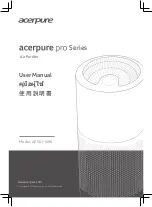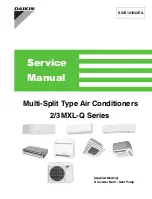
Page 21
31-5000752 Rev. 0
Defrost System Sensors
Sensors connect to the defrost board through a field–
replaceable harness assembly that plugs into the board.
Through the sensors, the board detects outdoor ambient
and coil fault conditions. As the detected temperature
changes, the resistance across the sensor changes.
Sensor resistance values can be checked by ohming
across pins.
NOTE:
When checking the ohms across a sensor, be
aware that a sensor showing a resistance value that is not
within the range shown, may be performing as designed.
However, if a shorted or open circuit is detected, then the
sensor may be faulty and the sensor harness will needs to
be replaced.
Sensor
Temperature
Range
°
F (
°
C)
Red LED
(DS1)
Pins / Wire
Color
Outdoor
(ambient)
-35 (-37) to
120 (48)
280,000 to
3750
3 & 4
(black)
Coil
-35 (-37) to
120 (48)
280,000 to
3750
5 & 6
(brown)
NOTE
: Sensor resistance decreases as sensed temperature
increases.
Table 5. Sensor Temp. / Resistance Range
Coil Sensor
The coil temperature sensor considers outdoor
temperatures below -35°F (-37°C) or above 120°F (48°C)
as a fault. If the coil temperature sensor is detected as
being open, shorted or out of the temperature range
of the sensor, the board will not perform demand or
time/temperature defrost operation and will display the
appropriate fault code. Heating and cooling operation will
be allowed in this fault condition.
NOTE:
The coil temperature probe is designed with a
spring clip to allow mounting to the outside coil tubing. Coil
sensor location is important for proper defrost operation.
Ambient Sensor
The ambient sensor considers outdoor temperatures
below -35°F (-37°C) or above 120°F (48°C) as a fault. If the
ambient sensor is detected as being open, shorted or out
of the temperature range of the sensor, the board will not
perform demand defrost operation. The board will revert
to time/temperature defrost operation and will display the
appropriate fault code. Heating and cooling operation will
be allowed in this fault condition.
NOTE:
Within a single room thermostat demand, if 5-strikes
occur, the board will lockout the unit. Control board 24 volt
power “R” must be cycled “OFF” or the “TEST” pins on
board must be shorted between 1 to 2 seconds to reset
the board.
Defrost Temperature Termination Shunt (Jumper)
Pins
The defrost board selections are: 50, 70, 90, and 100°F
(10, 21, 32 and 38°C). The shunt termination pin is factory
set at 50°F (10°C). If the temperature shunt is not installed,
the default termination temperature is 90°F (32°C).
TEST PINS
DEFROST
TERMINATION
PIN SETTINGS
SENSOR
PLUG-IN
(COIL &
AMBIENT
SENSORS)
DELAY PINS
REVERSING
VALVE
PRESSURE
SWITCH
CIRCUIT
CONNECTIONS
LOW
AMBIENT
THERMOSTAT
PINS
DIAGNOSTIC
LEDs
24V TERMINAL
STRIP
CONNECTIONS
Note -
Component
Locations Vary
by Board
Manufacturer
Figure 8. Control Board
Содержание GE APPLIANCES NS17HS
Страница 7: ...Page 7 31 5000752 Rev 0 Figure 1 Typical Parts Arranegment Figure 2 Typical Parts Arranegment...
Страница 29: ...Page 29 31 5000752 Rev 0 Figure 11 Typical Factory Wiring 018 through 036 models...
Страница 30: ...Page 30 31 5000752 Rev 0 Figure 12 Typical Factory Wiring 042 through 060 models...
Страница 31: ...Page 31 31 5000752 Rev 0 Figure 13 Wiring Diagram 018 036 Models...
Страница 32: ...Page 32 31 5000752 Rev 0 Figure 14 Wiring Diagram 042 060 Models...
Страница 43: ...Page 43 31 5000752 Rev 0 Notes...
















































